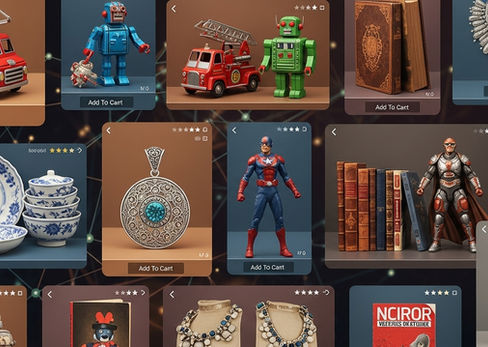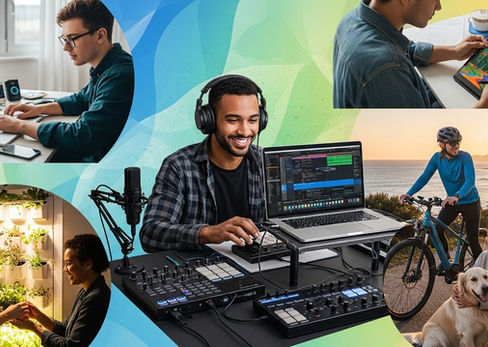AI Avatar Creation: Free Tools and Prompts for Unique Digital Identities
- THE MAG POST

- Sep 13
- 6 min read

AI avatar creation is rewriting how we present ourselves online, offering instantly customizable characters that reflect personality without requiring graphic design skills. The rise of accessible tools means anyone can craft stylized personas for social profiles, games, or professional branding, often within minutes.
Choosing prompts carefully, iterating with feedback, and staying mindful of privacy and licensing unlocks the full potential of AI avatar creation. By blending practicality with creativity, you’ll learn how to translate imagination into vivid, shareable digital identities across platforms and contexts.
AI Avatars Transform Digital Identity
Digital identity is no longer a fixed image; AI-driven avatars unlock nuance, personality, and context with remarkable speed. They empower individuals to present themselves consistently across platforms, games, and professional spaces without specialized design knowledge.
As tools become free and accessible, the opportunity to experiment grows. AI avatar creation lets you test different looks, attitudes, and environments, then refine them into a cohesive digital persona that adapts to audience and occasion while preserving your core essence.
Foundations of a Powerful Avatar
Effective avatars begin with a clear sense of purpose. Start by mapping who the avatar is for, what impression you want to convey, and which channels will host the character. Translate those goals into concrete attributes such as hairstyle, coloration, attire, and facial expressions that align with the intended context.
Visual language matters as much as technical quality. Pick a style that suits your content cadence, whether realistic, cartoon, or semi realistic, and ensure accessibility through readable contrast and legible expressions. Early decisions about lighting, background simplicity, and pose streamline later refinements and support cross platform consistency.
Real-World Use Cases Across Platforms
AI avatars flourish in social profiles, streaming identities, branded mascots, and game characters. A single avatar can morph through variations in clothing, background, and mood while retaining core identity, enabling flexibility without sacrificing recognition.
Examples span professional and creative realms: a polished headshot vibe for corporate networks, a playful character for gaming streams, and a cinematic figure for narrative storytelling. Tailoring avatars to audiences sustains authenticity while maximizing engagement and recall across channels.
Design Mechanics: Visuals that Speak
Visual design choices shape how your avatar communicates before any words are spoken. The right balance of detail, color, and style can convey personality, mood, and credibility in a single glance.
Beyond individual features, composition matters. Backgrounds, lighting, and color harmony should reinforce the avatar’s role, whether intimate and approachable or bold and authoritative. Consistency across multiple avatars or variations strengthens brand identity and audience trust.
Visual Vocabulary: Hair, Skin, and Attire
Assemble a visual lexicon that matches your narrative. Hair textures, skin tones, and clothing silhouettes should reflect character, culture, and context while remaining respectful and inclusive. Start with a few baseline options and expand gradually to explore diverse representations without overcomplicating the prompt.
Attention to fabric texture, accessory choices, and color relationships elevates realism or stylization as needed. Use controlled palettes to maintain cohesion across variants, and document successful combinations so future prompts can reproduce preferred outcomes with little guesswork.
Mood and Expression: Conveying Character
Expression choices communicate attitude, emotion, and intent. Decide whether the avatar should appear welcoming, confident, curious, or enigmatic, and select corresponding eye shapes, brow positions, and mouth lines. Subtle lighting and shadow cues can amplify mood without adding clutter.
Consistency in expression across contexts reinforces identity. When a character appears in different scenes, maintain a recognizable facial framework and color scheme so audiences immediately recognize the avatar, even as backgrounds or outfits change.
A Practical Creation Workflow for Free Tools
Moving from idea to image is a repeatable, approachable process that emphasizes clarity and iteration. A streamlined workflow reduces friction and accelerates results, making high quality avatars accessible to learners, freelancers, and brands alike.
Embrace a disciplined cycle of concept, prompt, generate, and refine. Free platforms offer a treasure trove of style presets and adjustable parameters; the real skill lies in crafting precise prompts and evaluating outputs with a critical eye for detail, balance, and storytelling potential.
Prompt Architecture: Crafting Effective Prompts
Prompts should foreground appearance, style, environment, and lighting in a structured way. Start with a concise description of core features, then specify the chosen art style, scene context, and rendering quality. Clear sequencing helps the AI prioritize essential elements and reduce ambiguity in the final image.
Include small but decisive details such as hair texture, garment patterns, and background mood to push the output toward your vision. Save successful prompts to reuse or adapt, creating a personal library that speeds up future avatar generations.
Iterative Refinement: From Draft to Final
Generation is just the beginning; effective avatars emerge through deliberate refinement. Review previews critically, identify missing details, and adjust prompts to address gaps in hair, expression, or lighting. Iterate with gentle refinements rather than sweeping changes to preserve core identity.
Track the outcomes of each iteration, noting what variations yield the most authentic results. A small set of high quality iterations can outperform numerous broad replacements, saving time and delivering a more polished final avatar suitable for multiple contexts.
Free Resources and Practical Tips
Free tools democratize avatar creation, but selecting the right platform and approach matters. Prioritize user friendly interfaces, meaningful customization options, and reliable export quality to maximize results without investment.
Practical prompts, style presets, and iteration habits convert exploration into tangible assets. Build a small toolkit of reliable prompts, consistent style references, and a checklist for finalizing avatars that scale across platforms and campaigns.
Choosing Free Platforms: What to Look For
When selecting a free platform, seek intuitive prompts, robust style controls, and clear licensing terms. A good tool will offer a range of styles, reasonable resolution options, and an easy path to save or export variants for reuse in future projects.
Additionally, assess how well a platform supports iteration, preview enrichment, and prompt management. Platforms with prompt histories or templates reduce cognitive load and help you reproduce successful results with confidence.
Quality Levers: Resolution, Style, and Consistency
Resolution influences how avatars perform on different screens and in various contexts, so plan for outputs that scale without losing detail. Style coherence across outfits, backgrounds, and expressions reinforces recognition and professionalism.
Establish a baseline color palette and shape language for all avatars in a project. Consistency across assets minimizes confusion, strengthens branding, and delivers a cohesive user experience across social, gaming, and marketing channels.
Ethics, Privacy, and the Road Ahead
As with any powerful creative tool, AI avatar creation requires thoughtful ethics and privacy mindfulness. Transparent use, consent, and accurate representation protect both creators and audiences while enabling responsible innovation.
Looking forward, interoperability and licensing clarity will shape how avatars move between platforms and projects. Staying informed about evolving standards, data rights, and user safety helps creators harness AI responsibly while expanding creative possibility.
Ethical Considerations: Consent and Representation
Ensure that avatar designs do not misrepresent real individuals or infringe on personal likeness rights. Seek consent when representing others and provide clear attribution if necessary. Strive for inclusive representations that respect varied identities and communities across contexts.
Be transparent about avatar provenance and usage rights. Understanding licensing terms for generated images prevents disputes and supports sustainable creative practices, especially when avatars are used commercially or in public-facing campaigns.
Future Trends: Interoperability and Compliance
Anticipate a future where avatars seamlessly travel across apps and ecosystems. Interoperability will depend on standardized formats, interoperable metadata, and clear rights management that protects creators and users alike.
Compliance with evolving privacy regulations and platform policies will shape how avatars are stored, shared, and monetized. Proactive attention to these dynamics helps creators stay ahead of risk while leveraging new opportunities for digital storytelling.
Key Takeaways
AI avatars offer a powerful, accessible path to express identity across environments. By combining clear design intent, precise prompts, and disciplined refinement, you can build versatile characters that feel authentic and professional.
As tools evolve, prioritize ethical use, consistent visuals, and mindful licensing to sustain creative growth and audience trust across future platforms and projects.
Aspect | Summary |
Definition | AI avatar creation refers to generating digital characters using artificial intelligence, enabling customization without design skills. |
Key Tools | Free platforms like Grok and other generators provide prompts, style presets, and adjustable parameters for rapid outputs. |
Workflow Steps | Concept to prompt to input to adjust to generate, refine, and finalize with iterative prompts and previews. |
Best Practices | Be specific, test variations, track successful prompts, and respect licensing to ensure reuse and legality. |
Ethics | Consent, representation, and privacy considerations are essential when creating and using avatars publicly. |






















































Comments